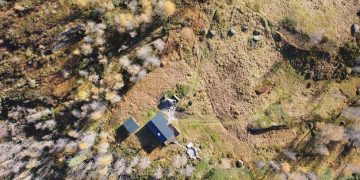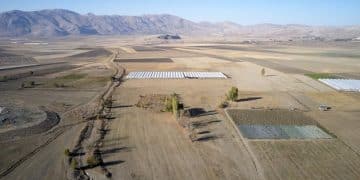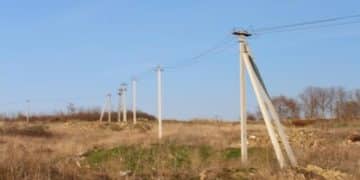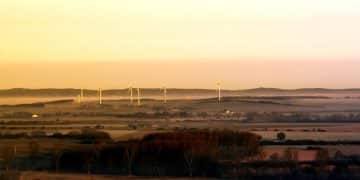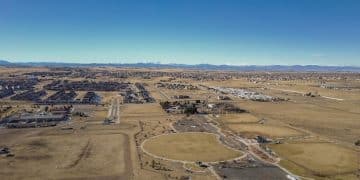Investing in US Offshore Wind Energy in 2025: Risks and Rewards
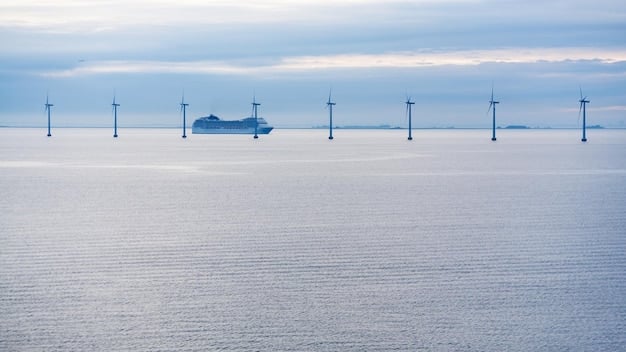
Investing in offshore wind energy projects in the US in 2025 presents a complex landscape of potential risks, including high upfront costs and regulatory hurdles, balanced by significant rewards such as long-term energy security, job creation, and contributions to renewable energy goals.
Are you considering investing in offshore wind energy projects in the US in 2025? The landscape is ripe with opportunity, but also fraught with challenges. Understanding the potential risks and rewards of investing in offshore wind energy projects in the US in 2025 is crucial for making informed decisions in this rapidly evolving sector.
Understanding the US Offshore Wind Energy Landscape in 2025
The offshore wind energy sector in the United States is poised for significant growth by 2025. Several factors contribute to this anticipated expansion, including increasing government support, technological advancements, and growing demand for renewable energy sources. However, the path forward is not without its complexities. Let’s delve into the key aspects that shape the current and future landscape of this industry.
Government Initiatives and Policy Support
Federal and state governments are playing a crucial role in driving the development of offshore wind energy. Through various initiatives and policies, they aim to accelerate project deployment and attract investments.
- Investment Tax Credits (ITC): These credits provide financial incentives for developers, reducing the upfront costs of projects and making them more economically viable.
- Production Tax Credits (PTC): Similar to ITCs, PTCs offer financial benefits based on the amount of electricity generated, encouraging long-term operation and efficiency.
- State-Level Mandates: Many states have established renewable portfolio standards (RPS) that require a certain percentage of electricity to come from renewable sources, including offshore wind.
Technological Advancements Driving Efficiency
Innovation is a constant force in the offshore wind industry, with advancements continually improving turbine performance and reducing costs.
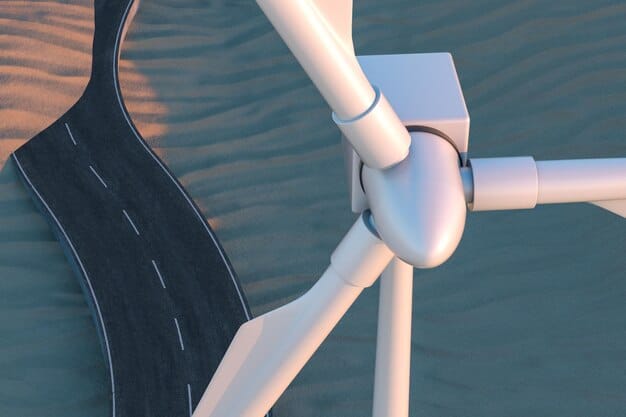
- Larger Turbine Sizes: The development of larger turbines with increased capacity factors allows for greater energy output from each installation.
- Floating Wind Technology: Floating turbines are enabling the development of wind farms in deeper waters, opening new areas for offshore wind development.
- Advanced Grid Integration: Improved technologies for transmitting electricity from offshore wind farms to the mainland grid are enhancing efficiency and reliability.
In conclusion, the US offshore wind energy sector in 2025 is characterized by strong government support, technological innovation, and increasing demand. Understanding these fundamentals is essential for assessing the potential risks and rewards associated with investing in this dynamic market.
Potential Economic Rewards of Offshore Wind Investments
Investing in offshore wind energy projects in the US offers several compelling economic rewards. These range from job creation and economic growth in coastal communities to long-term revenue streams and contributions to energy independence.
Job Creation and Economic Growth
The development and operation of offshore wind farms create numerous job opportunities across various sectors.
- Manufacturing and Construction: The manufacturing of turbine components and the construction of wind farms require skilled labor, boosting employment in these industries.
- Operations and Maintenance: Once operational, wind farms need ongoing maintenance, creating long-term jobs for technicians and engineers.
- Supply Chain Development: The growth of the offshore wind industry stimulates the development of local supply chains, creating additional economic opportunities for businesses.
Long-Term Revenue Streams and Energy Security
Offshore wind projects provide stable and predictable revenue streams over their operational lifetime.
- Power Purchase Agreements (PPAs): Long-term PPAs with utilities ensure a steady income for wind farm operators.
- Reduced Reliance on Fossil Fuels: Offshore wind contributes to energy security by reducing dependence on imported fossil fuels.
- Price Stability: Renewable energy sources like wind provide a hedge against volatile fossil fuel prices.
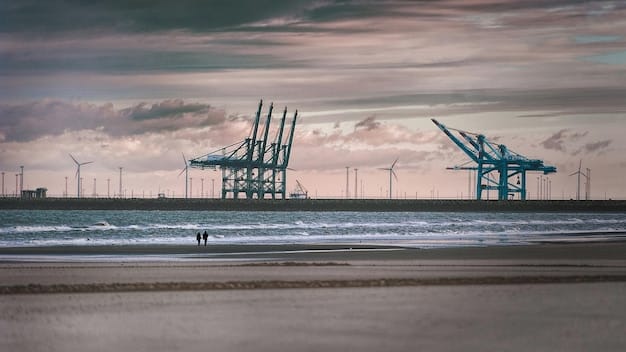
To conclude, investing in US offshore wind energy projects offers substantial economic rewards, including job creation, economic growth in coastal communities, stable revenue streams, and enhanced energy security. These benefits make offshore wind an attractive investment proposition for both private and public sectors.
Navigating the Risks: Challenges in Offshore Wind Development
While the potential rewards of investing in offshore wind energy are significant, it’s crucial to acknowledge and understand the inherent risks. These challenges can impact project timelines, costs, and overall success.
High Upfront Costs and Financing Challenges
Offshore wind projects require substantial initial investments, posing a barrier to entry for some developers.
- Turbine Manufacturing and Installation: The cost of manufacturing and installing large-scale turbines is a major expense.
- Transmission Infrastructure: Building subsea cables and onshore substations to connect wind farms to the grid adds to the overall cost.
- Financing Availability: Securing financing for these projects can be challenging, particularly for smaller developers.
Regulatory and Permitting Complexities
The regulatory landscape for offshore wind development in the US is complex and can lead to delays and increased costs.
- Environmental Impact Assessments: Extensive environmental studies are required to assess the potential impacts of wind farms on marine ecosystems.
- Permitting Processes: Obtaining permits from various federal and state agencies can be a lengthy and complex process.
- Stakeholder Engagement: Engaging with local communities and addressing their concerns is crucial for project approval.
In summary, understanding and mitigating the risks associated with high upfront costs, regulatory complexities, and supply chain constraints is essential for successful offshore wind development in the US.
Environmental Considerations and Mitigation Strategies
The environmental impact of offshore wind farms is a critical consideration for investors and developers. Understanding these impacts and implementing effective mitigation strategies is essential for ensuring sustainable development.
Potential Impacts on Marine Ecosystems
Offshore wind farms can have several potential impacts on marine life and habitats.
- Habitat Disturbance: Construction and operation of wind farms can disturb seafloor habitats and impact marine species.
- Avian Impacts: Wind turbines pose a risk to seabirds and migratory birds.
- Underwater Noise: Construction activities can generate underwater noise that affects marine mammals.
Mitigation Strategies and Best Practices
Several mitigation strategies can be implemented to minimize the environmental impacts of offshore wind farms.
- Careful Site Selection: Choosing locations that minimize impacts on sensitive habitats and bird migration routes is crucial.
- Noise Reduction Technologies: Implementing noise reduction technologies during construction can reduce the impact on marine mammals.
- Monitoring Programs: Conducting ongoing monitoring programs to assess the impacts of wind farms on marine ecosystems is essential for adaptive management.
To summarize, addressing environmental concerns through careful planning, mitigation strategies, and ongoing monitoring is crucial for ensuring the sustainable development of offshore wind energy in the US.
The Role of Technological Innovation in Mitigating Risks
Technological innovation plays a crucial role in mitigating the risks associated with offshore wind energy development. Advancements in turbine design, installation methods, and grid integration are enhancing efficiency, reducing costs, and minimizing environmental impacts.
Advanced Turbine Technologies
The development of larger and more efficient turbines is driving down the cost of offshore wind energy.
- Increased Capacity Factors: Larger turbines with higher capacity factors generate more electricity per turbine, improving project economics.
- Direct Drive Technology: Direct drive turbines eliminate the need for gearboxes, reducing maintenance costs and improving reliability.
- Floating Wind Foundations: Floating foundations enable the development of wind farms in deeper waters, expanding the potential for offshore wind energy.
Improved Installation and Maintenance Techniques
Innovative installation and maintenance techniques are reducing project timelines and minimizing downtime.
- Specialized Installation Vessels: Purpose-built vessels are improving the efficiency and safety of turbine installation.
- Remote Monitoring and Diagnostics: Advanced sensor technologies and data analytics enable remote monitoring and diagnostics, reducing maintenance costs.
- Autonomous Inspection and Repair: The use of drones and robots for inspection and repair tasks is improving efficiency and reducing risks.
In short, technological innovation is a key driver of progress in the offshore wind industry, mitigating risks, reducing costs, and enhancing the overall performance and sustainability of projects.
Policy and Regulatory Outlook: What to Expect in 2025
The policy and regulatory environment for offshore wind energy is constantly evolving. Understanding the key trends and potential changes in 2025 is essential for investors and developers.
Federal and State Policy Developments
Government policies and regulations play a significant role in shaping the future of offshore wind energy.
- Renewable Energy Targets: States with ambitious renewable energy targets are driving demand for offshore wind.
- Federal Leasing and Permitting: The Bureau of Ocean Energy Management (BOEM) oversees the leasing and permitting process for offshore wind projects in federal waters.
- Tax Incentives and Subsidies: Federal tax incentives and state subsidies can significantly improve the economics of offshore wind projects.
Potential Policy Changes and Their Impact
Changes in government policies and regulations can have a significant impact on the offshore wind industry.
- Inflation Reduction Act: This legislation includes significant investments in renewable energy, including offshore wind, through tax credits and other incentives.
- Permitting Reform: Efforts to streamline the permitting process could accelerate project development.
- Grid Modernization: Investments in grid infrastructure are needed to support the integration of offshore wind energy.
In conclusion, staying informed about policy and regulatory developments is crucial for navigating the evolving landscape of offshore wind energy in the US and making informed investment decisions.
| Key Aspect | Brief Description |
|---|---|
| 💰 Economic Rewards | Job creation, revenue streams, energy security. |
| ⚠️ Potential Risks | High costs, regulatory hurdles, environmental impacts. |
| 🌱 Environmental Mitigation | Careful site selection, noise reduction, monitoring programs. |
| ⚙️ Tech Innovation | Advanced turbines, improved installation, remote monitoring. |
Frequently Asked Questions
▼
Investing in offshore wind leads to job creation, stimulates local economies, provides predictable revenue streams through long-term power purchase agreements, and contributes to energy security by reducing reliance on fossil fuels.
▼
The predominant risks are high upfront capital costs, complex regulatory processes, potential environmental impacts, and technological challenges related to turbine performance and grid integration.
▼
Environmental concerns are mitigated through careful site selection to avoid sensitive habitats, implementation of noise reduction technologies during construction, and ongoing monitoring programs to assess long-term impacts.
▼
Technology is crucial, driving innovation in turbine design for increased efficiency, improving installation methods to reduce costs and timelines, and enhancing grid integration for more reliable energy delivery.
▼
Government policies significantly influence offshore wind investments through renewable energy targets, federal leasing and permitting processes, and tax incentives and subsidies that can improve project economics substantially.
Conclusion
In conclusion, investing in US offshore wind energy projects in 2025 presents a complex decision-making process that requires careful consideration of both the potential rewards and inherent risks. By understanding the economic benefits, environmental considerations, technological advancements, and policy landscape, investors can make informed choices and contribute to the growth of this promising renewable energy sector.
